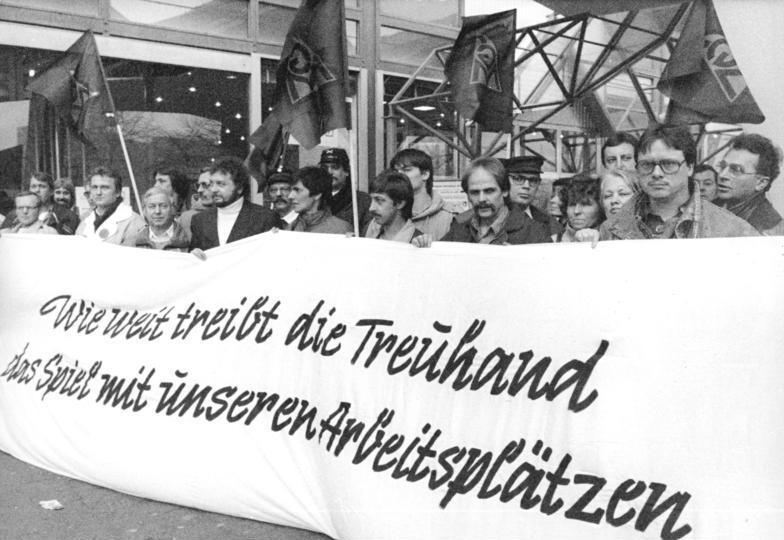Authors
Guido Friebel
(Goethe University Frankfurt and RFBerlin)
Casper Berg Lavmand Larsen
(Copenhagen Business School)
Johannes Laust Reese Hansen
(Rockwool Foundation)
A newly conducted nationwide survey of cooperation committees and trade union representation provides entirely new insights into the landscape of co-determination institutions in Danish firms. For the first time, we now have a dataset that maps the complete landscape of co-determination institutions; cooperation committees, trade union representation, board-level employee representation, and workplace environment committees on firm level, and unionization on employee level. This provides entirely new opportunities to understand both the isolated effects and the interplay between these different forms of co-determination within firms and in the labor market more broadly.
This newsletter offers the first descriptive insights.
Definition: Co-determination
Co-determination refers to systems of corporate governance that gives employees, or their representatives, formal rights to participate in the decision making process alongside management. Co-determination can take many forms, but the most common structures are employee representation on the board of directors and cooperation committees. However, they all share the goal of giving a voice to employees and fostering cooperation within the firm.
Understanding of the relationship between employees and firms has come back to the fore-front in economic policy discussions. And in particular, there has been an increasing interest and demand for successful Nordic co-determination and labor market solutions (e.g. Kochan et al. (2019)).
Denmark is known for its flexicurity labor market model, which combines significant flexibility in the employer’s right to hire and fire employees (the flexibility component), a relatively strong economic safety net in the event of unemployment (the security component), and an active labor market policy (Kreiner and Svarer (2022)). The flexicurity model has proven its viability by ensuring a low level of conflict between employers and employees, as well as a strong ability to absorb shocks to the economy.
Co-determination institutions are likely to be crucial for the viability of the flexicurity model. Yet, there is a lack of substantial knowledge about the role of individual co-determination institutions. Specifically, more research is needed on the relationship between employees and firms, and how these relationships impact productivity, employees’ well-being, and the broader functioning of labor markets.
Previous research has primarily investigated how co-determination affects monetary out-comes such as firm performance or wages (see Jäger et al. (2022) for an overview). The Rockwool Foundation project aims to broaden this focus by examining the impact on non-monetary factors important to employees, such as job satisfaction, health, and motivation. Here, however, we address a different question: What kinds of firms adopt co-determination, and which do not?
It is crucial for any policy debate on the possibility of strengthening the representation of employees interests through co-determination, to know what the trade-offs associated with these institutions are.
FACT BOX 1: Co-determination rights in Denmark
In Denmark, the legal framework governing co-determination includes coop-eration committees, trade union representatives, and board-level employees representation.
Cooperation committees (the Danish counterpart to German works councils) are mandatory in firms with 35 or more employees if requested by either the employer or a majority of employees. These committees must have equal representation from both sides and aim to promote cooperation between employers and employees. They have rights to information and consultation but lack veto powers, unlike in Germany. Management is required to share important updates with the committee, such as financial positions and employment prospects, and the committee must help establish principles for local working and welfare conditions. While the committee does not handle pay negotiations, it can offer consultation on disputes, though final decisions rest with management.
Trade union representatives negotiate on behalf of employees for wages, benefits, and working conditions. They ensure compliance with collective bargaining agreements negotiated by employers or employer associations.
Union representatives also support employees in legal matters, including disputes over contracts, unfair dismissal, and workplace rights, ensuring that employees are informed of and receive their legal entitlements. Additionally, trade union representatives are members of the firm’s cooperation committee.
Board-level employee representation allows employees in firms with at least 35 employees to elect board-level representatives, though this is a right rather than an obligation. Employees can elect up to one-third of the board, and employee-elected board members have the same rights (including voting rights) and responsibilities as shareholder-elected members. Voluntary employee representation is also allowed in firms with fewer than 35 employees if accepted by the employer.
It should be noted that the legal framework governing co-determination differs across countries, which limits the generalizability of the patterns presented here. For instance, works councils in Germany, which are the equivalent of cooperation committees, have a more influential mandate than their Danish counterparts. In Germany, works councils provide significant representation for employees at the workplace, with substantial powers, including an effective right of veto on certain issues. Additionally, in terms of board-level employees representation in Germany, employees are entitled to seats on the supervisory board of larger firms — one-third in firms with 500 to 2,000 employees and half in those with more than 2,000 employees.
Securing employees’ rights to co-determination does not guarantee implementation
Despite employees gaining legal right to different forms of co-determination at the 35-employee threshold, significant variation persists in actual implementation. Trade union representation is the most widespread form of co-determination in Danish firms. Overall, 65 percent of firms have at least one trade union representative. Next are cooperation commit-tees, which have been adopted by 49 percent of firms, and finally, employee directors, who are elected in 20 percent of the firms subject to the legislation¹
1) The share of limited liability firms with more than 35 employees (firms subject to legislation on co-determination) who have adopted different forms of representation is as follows: 49 percent have a cooperation committee (2024), 65 percent have a union representative (2024), and 20 percent have board-level employee representatives (2021).
Figure 1: Industry distribution of co-determination
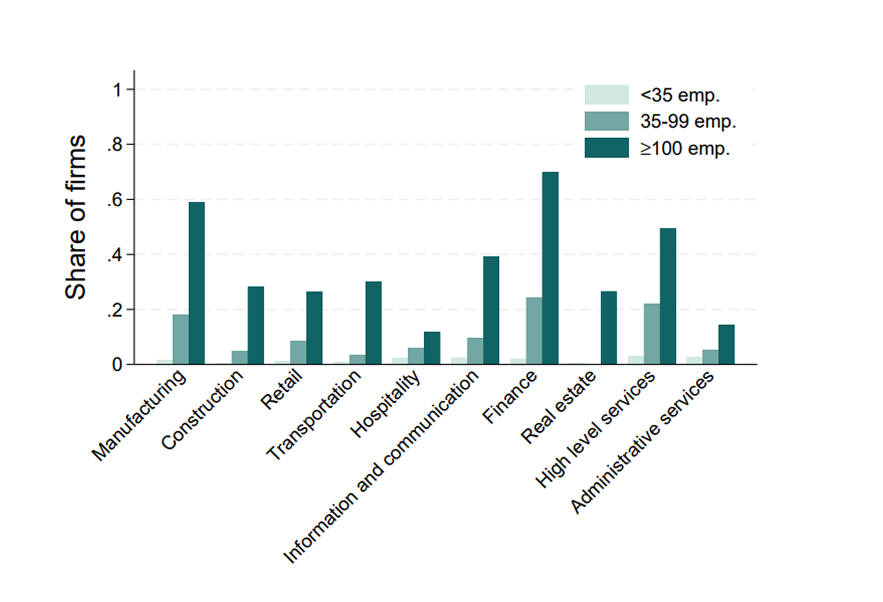
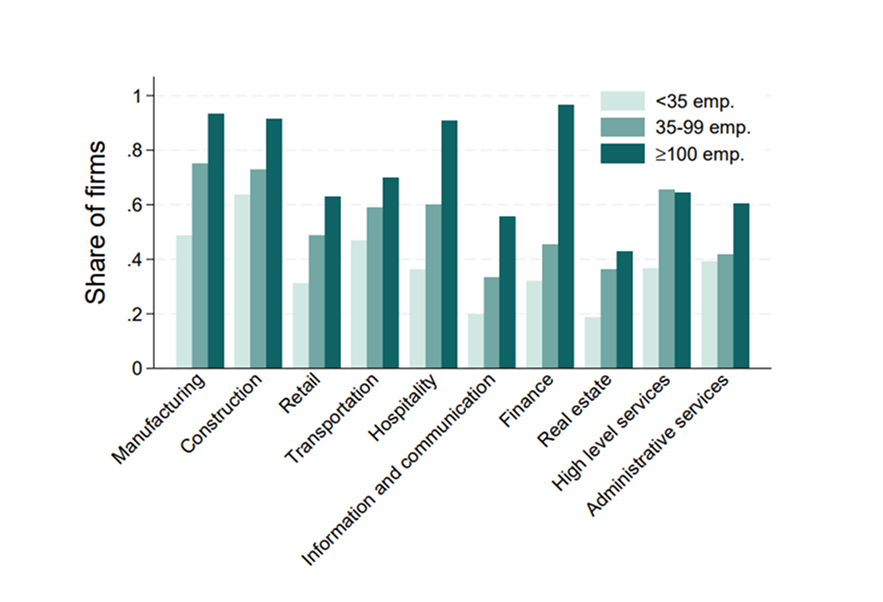
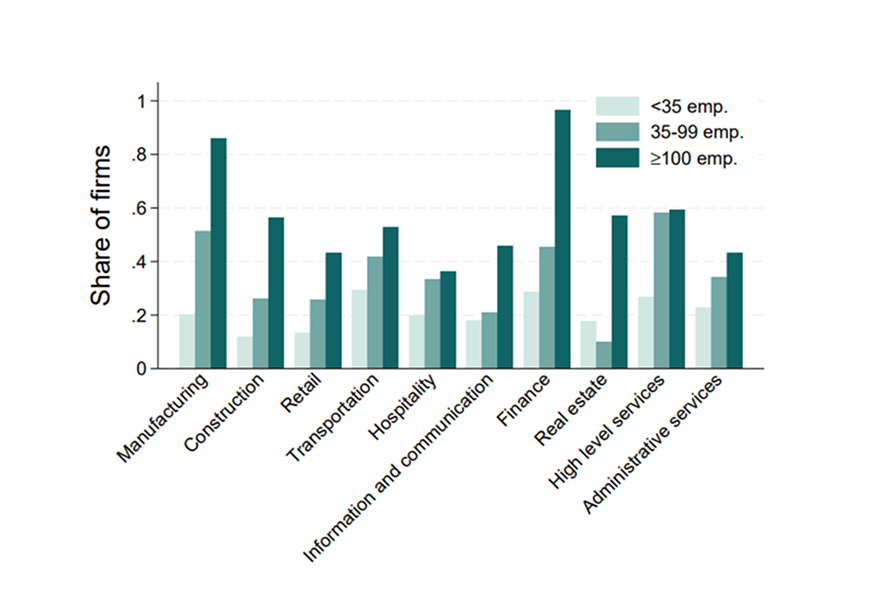
Note: This figure shows the share of firms with board representation and cooperation committees,respectively, by whether the employees have the statutory right to these institutions (limited liability firms with 35 or more employees). BLER is an acronym for board-level employee representation.
Source: Own calculations based on administrative data from Statistics Denmark and a survey.
Moreover, there is a great variation across industries and firm sizes when it comes to the im-plementation of cooperation committees, employee-elected board members, and trade union representation, as illustrated by figure 1.
Co-determination is particularly widespread in industries such as manufacturing, construc-tion, and finance. The high prevalence of firm-level co-determination institutions in indus-tries such as manufacturing and finance is likely related to the unionization rates among employees. In these industries, unions have a tradition of being involved in the training and positioning of employee candidates for cooperation committees and board-level employee representation.
In contrast, co-determination institutions are rarely adopted in industries such as retail, in-formation/communication, and administrative services, despite employees having the same rights to implement cooperation committees, employee-elected board members, and trade union representation.
FACT BOX 2: Our survey
In late 2024, we conducted a survey of Danish limited liability firms in collaboration with Statistics Denmark. The survey asks whether firms have established cooperation committees, trade union representation, and workplace environment committees, while also collecting information on the collaboration climate and the issues addressed in the cooperation com-mittees specifically. A total of 8,300 limited liability firms in Denmark, each with at least 20 employees over the past 12 months, were invited to participate. Of these, 40.7 pct. (3,385 firms) responded, representing about 34.6 pct. of all Danish limited liability firms with 20 or more employees in 2024.
By combining our new survey with existing administrative records, we have, for the first time, created a comprehensive dataset that offers a full view of co-determination in Danish firms. At the start of the project, we already knew which firms had elected employee representatives on their boards, as well as which employees were members of trade unions. However, in with our project funded by ROCKWOOL Foundation Berlin, we have now added information on which firms have established cooperation committees, trade union representation, and workplace environment committees.
Figure 2: Predictors of co-determination
Board-level employee representation
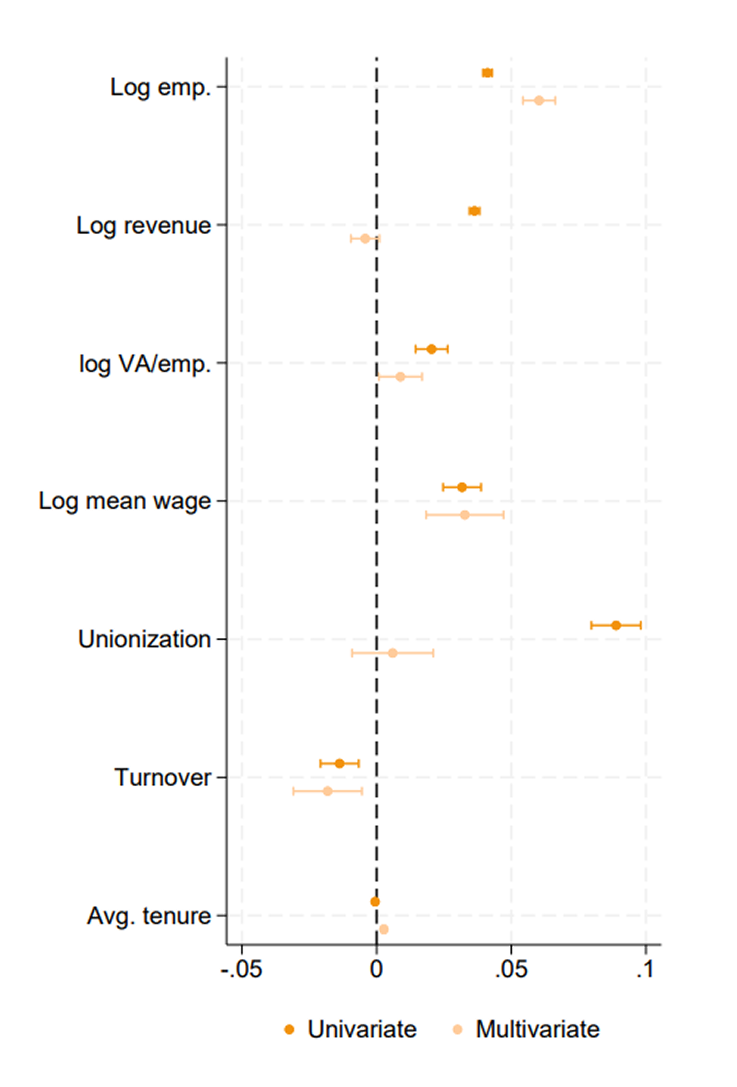
Cooperation committee
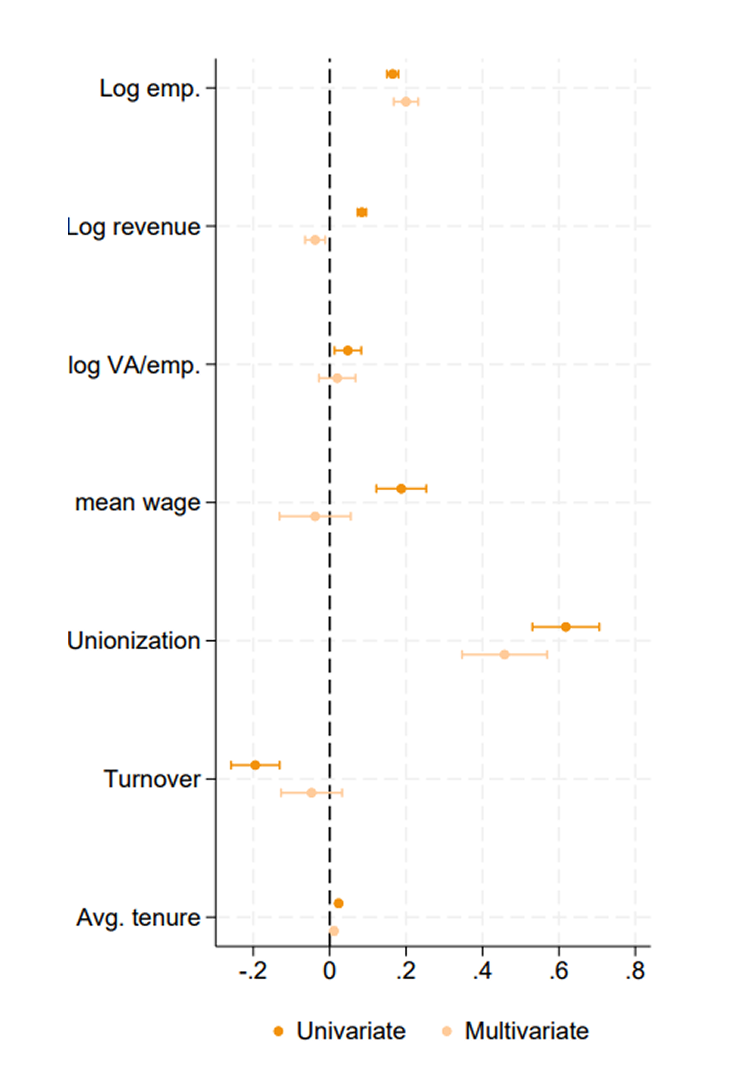
Note: This figure shows the estimated coefficient for both univariate and a multivariate regression of firm characteristics on a dummy for either board level representation or cooperation committee being present at the firm.
Co-determination institutions are strongly interdependent
Another interesting pattern in the prevalence of co-determination institutions is their strong interdependency: the presence of one institution significantly increases the probability of others being adopted. As shown in Figure 3, these dependencies are striking. For instance, firms with cooperation committees are over seven times more likely to have board-level representation than those without, and firms with union representatives are more than four times more likely to have works councils than those without. These patterns raise a critical question: Do different forms of co-determination act as complements—where one enhances the effectiveness of another—or as substitutes for one another?
Figure 3: Ratio of probabilities of implementation of different forms of co-determination
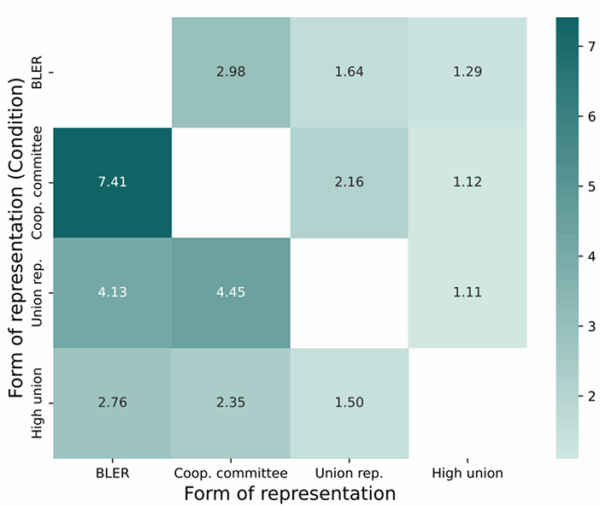
Note: This figure shows the ratio of the probability of having implemented a given form of co-determination (x-axis) of those with a given other form of representation (y-axis) over those without it.
Source: Own calculations based on administrative data from Statistics Denmark and a survey.
How do co-determination institutions affect workplaces?
Going forward, the project aims to uncover the causal impact of the presence of these differ-ent institutions in firms as well as their inter dependencies.
Matching our survey and administrative register data with large scale surveys of employees on work environment and health, we can examine how these institutions impact outcomes where we expect them to have the greatest impact, such as work environment, management quality, etc. to better understand the role of co-determination institutions within firms and in the labor market more broadly.
This newsletter provide first insights into the landscape of co-determination in Danish firms. And it is precisely the variations and dependencies across different forms of co-determination that we aim to unpack in much greater detail in the project moving forward.
Main takeaways
When we compare firms with employees who are subject to the same formal rights to establish cooperation committees, elect board members, and appoint trade union representatives, we arrive at the following main findings:
- Co-determination institutions are deeply rooted in a large fraction of Danish firms. Among firms subject to legislation, 65 percent of firms have at least one trade union representative, 49 of firms have adopted a cooperation committee, and 20 of firms elect employee directors.
- At the same time, however, co-determination institutions are rarely adopted in industries such as retail, information/communication, and administrative services, despite employees having the same rights to implement cooperation committees, employee-elected board members, and trade union representation.
- Co-determination institutions are interdependent. For example, it is 7.4 times more likely that employees elect members to the board of directors in a firm when the firm has established a cooperation committee.
REFERENCES
Amore, M., M. Bennedsen, B. Larsen, & Z. Zhao Optimizing the workplace: The interplay between working environment, corporate outcomes and employee well-being. CEPR Discussion Paper No. 19298. (2024)
Blandhol, C., Mogstad, M., Nilsson, P., & Vestad, O. L. Do employees benefit from worker representation on corporate boards? The economic journal (forthcoming)
Gregorič, A. and Poulsen, T. When Do Employees Choose to Be Represented on the Board of Directors? Empirical Analysis of Board‐Level Employee Representation in Denmark British Journal of Industrial Relations 58 (2): 241-272. (2020)
Harju, J., Jäger, S., & Schoefer, B. Voice at work. American Economic Journal: Ap-plied Economics (forthcoming)
Mueller, S. & Stegmaier, J. The Dynamic Effects of Works of Works Councils on Labour Productivity: First evidence from Panel Data British Journal of Industrial Relations 55 (2): 223-459. (2017)
Jäger, S., Schoefer, B., & Heining. J. Labor in the Boardroom. Quarterly Journal of Economics 136 (2): 669-725. (2021)
Jäger, Simon, Shakked Noy, and Benjamin Schoefer. What does codetermination do?. ILR Review 75.4 (2022): 857-890.
Kochan, T. A., Yang, D., Kimball, W. T., and Kelly, E. L. Worker Voice in America: Is There a Gap between What Workers Expect and What They Experience? ILR Review, 72 (1): 3–38. (2019)
Kreiner, Claus Thustrup, and Michael Svarer. Danish Flexicurity: Rights and Duties. Journal of Economic Perspectives, 36 (4): 81–102. (2022)

